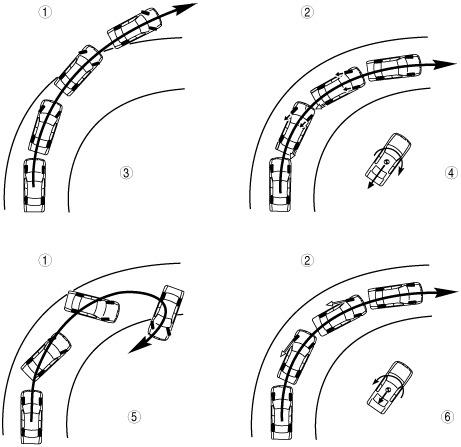DYNAMIC STABILITY CONTROL (DSC) OUTLINE
id041500100300
• The DSC HU/CM, integrating both the hydraulic unit (HU) and control module (CM), has been adopted, resulting in a size and weight reduction.
• A combined sensor, integrating both the yaw rate sensor and lateral-G sensor, has been adopted, improving serviceability.
• The specialized controller area network (CAN) system has been adopted for use between the combined sensor and DSC HU/CM, improving serviceability and reliability.
• An enhanced malfunction diagnosis system, used with the Mazda Modular Diagnostic System (M-MDS), improving serviceability.
DSC Operation Outline
• The ABS prevents wheel lock-up during braking. The TCS detects drive wheel spin due to the accelerator pedal being pressed too hard or similar causes and controls engine speed to suppress wheel spin. With these systems, safety is assured when driving or stopping.
• Additionally, sudden changes in vehicle attitude, due to evasive steering or road conditions, are controlled by the DSC. The DSC suppresses vehicle sideslip when driving due to vehicle spin (oversteer) or drift-out (understeer) by controlling braking and engine speed. At this time, the DSC indicator light illuminates to alert the driver that the DSC is operating due to a dangerous situation. As a result, the driver can calmly react and is provided leeway for the next maneuver, resulting in safe driving conditions.
• In this way the combination of DSC + ABS + TCS ensures driving, stopping and turning safety in all aspects.
Results Of DSC Operation
|
1
|
Without DSC
|
|
2
|
With DSC
|
|
3
|
Drift out (understeer)
|
|
4
|
Drift out (understeer) suppression
|
|
5
|
Vehicle spin (oversteer)
|
|
6
|
Vehicle spin (oversteer) suppression
|
-
Caution
-
• While the DSC is a steering safety system, it does not improve normal steering function. Therefore, always drive carefully, even if the vehicle has DSC, and do not overestimate the DSC capability.
• If the initialization procedures for the combined and brake fluid pressure sensors are not performed correctly, an incorrectly determined initial point may cause a discrepancy between the actual driving conditions of the vehicle and the signals from the sensors, resulting in improper DSC operation. Therefore, after replacing or removing the following parts, make sure to perform the DSC HU/CM initialization procedures of the sensors with the vehicle stopped on a level ground to insure proper DSC operation. For the initialization procedures of the sensors, refer to the Workshop Manual.
-
― DSC HU/CM
― Combined sensor
• The DSC and ABS will not operate normally under the following conditions:
-
― With tires that are not of the specified size, manufacturer or tread pattern, or not inflated according to specification
― With tires that have significant comparative wear variation
― With tire chains
― With an emergency spare tire
